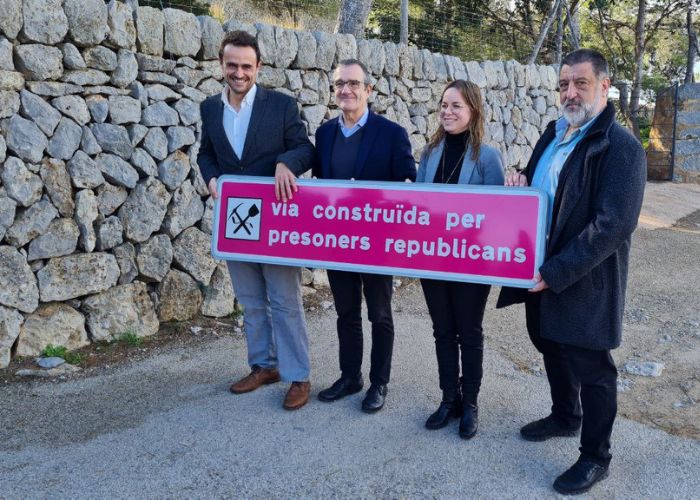MALLORCA – On Wednesday a special project was launched on the island of Mallorca. From now on, permanent attention is paid to the roads built with slave labour on the island of Mallorca during the Franco regime.
The Government and the Consell de Mallorca participated in the presentation of the signalling project. It concerns more than 160 kilometres of highway. These roads were built by more than 8,000 prisoners from the labour camps that were opened on the island after the 1936 coup.
In the municipalities of Sóller, Calvià, Alcúdia/Pollença, Manacor, Llucmajor and Campos, six large information boards pay tribute to the slaves of Franco. They tell the story of the roads they built in often degrading conditions.
Up to 26 concentration camps in Mallorca
Juan Pedro Yllanes, Vice President of the Government and Minister of Energy Transition, Productive Sectors and Democratic Memory, stressed there were 26 concentration camps in Mallorca alone. “It is estimated that between 1936 and 1942 more than 8,000 people were forced into hard labour under very poor food and working conditions. They built roads, bunkers and other structures all over the island,” he said. He added the aim was “to strengthen the military defences of the coast”. But “also for a possible landing of Allied forces during World War II”.
With this project, the island government wants to recognise forced labourers
The signalling project has been jointly promoted by the General Directorate of Democratic Memory of the Government and the Consell de Mallorca. They want to give recognition to all those forced labourers who built the existing main roads of the island. The scope of the forced labour system imposed by the Franco regime is highlighted by the signalling project as part of restoring the islands’ democratic memory, Illanes stressed.
Information panels
The first panel was installed in Sóller, next to the viewpoint of the Muleta lighthouse. It stands on a road built between 1936 and 1938 by prisoners in Mallorca and on the peninsula. The second will be installed in Calvià, near the Es Capdellà labour camp. Three others are placed around the strategic circuit of MA-6014 in the municipalities of Llucmajor, Manacor and Campos. Finally, a sixth panel is on the road that connects Alcúdia to Puerto de Pollença. At least seven labour camps were located in this area.
The slaves of Franco will not be forgotten
According to Iván Sevillano, Minister of Mobility and Infrastructure, this project shows “sensitivity to those who suffered Franco-era reprisals”. “The best way to avoid repeating the tragic events of the past is to remember and not forget.”
Furthermore, the government and the Consell de Mallorca will place a total of 60 signs along 166 kilometres of road. At the beginning and the end of the road and every five kilometres another sign. Of these, 133 kilometres belong to Consell roads and 32.5 kilometres to those managed by other governments.
Related: Spanish Parador Hotel reluctantly acknowledges gruesome past
The initiators of the project want to share both the iconography and the text of the signs with other governments in Spain that “want to participate” in the project. In “all municipalities” there were “republican prisoners who had to build hundreds of roads under duress and violence.
The oppression of the island
The works carried out between 1936 and 1942 made it possible to strengthen the coastline. They also improved the precarious road and rail connections and opened new accesses to the coast. Historian Jaume Claret Miranda pointed out that “when Spain became an immense prison, Mallorca was doubly so because of its isolation and the number of fields that marked the whole geography”. He wrote that in the prologue of the book Esclaus oblidats. The concentration camps in Mallorca, by Maria Eugènia Jaume I Esteva (2019, Documenta Balear), is one of the latest works on these detention centres.
In this book, the researcher claims that the island was a place where repression and fear were applied to broad sectors of society: “public humiliation, killing, imprisonment … Many people were eliminated.” Those who were not killed were put in prisons where they were tortured and others ended up in concentration camps.
The prisoners of the Franco regime were classified according to their degree of dissatisfaction with the National Movement”. They then ended up in labour battalions in a slave or semi-slavery labour regime without being tried or convicted.
Related: Archaeologists discover almost intact concentration camp in Spain


